Christie Chang, Dorsa Massihpour, Samantha Wong
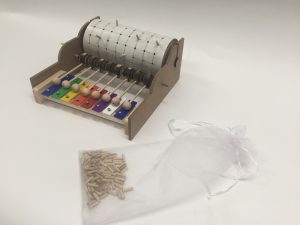
Description
This toy is a hand-crank xylophone with a motorized attachment. Children interact with the toy by inserting or removing the wooden pegs into the holes in the barrel to create different songs. The barrel is then rotated by hand or the motorized attachment, and the pegs raise the mallets, which hit the xylophone.
This toy is meant for children between the ages of 6-10 to allow them to explore music and learn the basics of one octave on the xylophone. They can play around with different tunes, play familiar songs like Twinkle Twinkle Little star, or create their own songs and record the notes on sheet music.
Learning Goals
The main learning objective of the toy is to understand how different pitches and individual notes sound and how they can form melodies. Additionally, children can learn about how speed and rests between notes affects the way a song is perceived.
Operation Info
Safety
The main safety concern for the toy is for very young children to swallow the pegs, however they are not sharp and are just made from wood which is likely non-toxic.
Operating the Toy
Our xylophone contains a barrel into which pegs can be placed to produce different songs. The crank can be turned by hand, or the dial on the motor can be switched on to turn the barrel automatically.
For the most part, the child can play with this toy on their own. Adult supervision may be necessary to ensure that the child does not swallow any of the parts, and to possibly assist with putting some of the pegs in and/or help guide their experimentation.
Some handouts related to the toy can be found below, which the adult can also help the child fill out or learn from.
For best results, turn the crank relatively slowly to avoid any damage to the toy and allow for the notes to be played clearly.
How do you make it?
Design:
There are multiple parts to the hand-crank xylophone, which can be both manually or automatically turned:
- Barrel
The barrel is made from a PVC pipe with a 6 inch diameter. Since there are eight keys in the xylophone we attach, we have 8 columns of 0.25 inch holes and 14 rows that wrap around the cylinder. Colored tape is attached to the column corresponding to the specific color of the xylophone keys. Two wooden circles with the equivalent diameter of the pipe are laser cut and glued to the ends of the pipe. These circles also have two small 0.25 inch diameters for a wooden dowel to fit through.
- Pegs
The pegs are cut from a 0.25 inch wooden dowel, each approximately 0.75 inches long. These pegs are cut to this size with a bandsaw, and each end are sanded slightly to fit through the holes of the barrel.
- Hand-crank
The hand crank is first laser cut into a 0.5 inch thick plywood for a clean outline, then is cut and polished with the bandsaw and belt sander. Two 0.25 inch holes are drilled into the two ends of the hand crank.
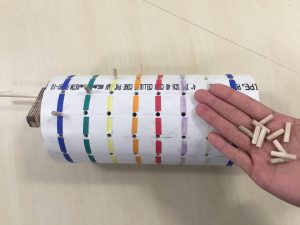
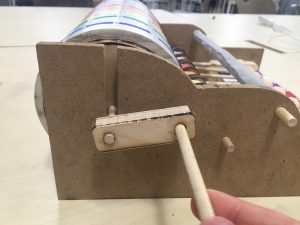
- Buttons
The buttons have a “P” shape made from ply sheet that is about 0.5 inches thick. The shape is first laser cut (with a prepared dxf file) in order to get a clean outline. The bandsaw is used to get the general shape cut out, but the belt sander is used for finishing touches. 0.25 inch circular holes are drilled in on the side, so that the buttons can spin on an axle, and 3/16 inch holes are drilled in the front, where the mallet sticks would be attached. Colored tape is also attached to the buttons corresponding to the specific color of the xylophone keys.
- Mallets
There are eight mallets in total. They are made from attaching a 3/16 wooden dowel to a wood round bead.
- Spacers
The spacers are made of wood and have a circular shape with a 0.25 inch circular hole in the middle. They are used for the two dowels attached to the barrel and buttons. For the barrel, one end of the barrel needed two spacers to ensure that the barrel will only spin and not move side by side. The spacers were also used to minimize side-by-side movement of the buttons since the mallets attached must hit a specific key on the xylophone.
- Block bar
The block bar is made of a 0.25 inch wooden dowel wrapped in felt material. This lock bar is placed slightly above the eight mallets to prevent the mallets from swinging too far back.
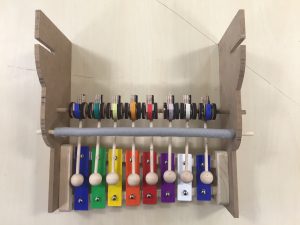
- Base part
The base part is two identical pieces made from a 0.25 inch thick plywood. The pieces both have two holes, one for the button dowels and the other for the block bar. There is also a slot where the dowel for the barrel can slide into. This slot allows the user to remove the barrel to insert the pegs.
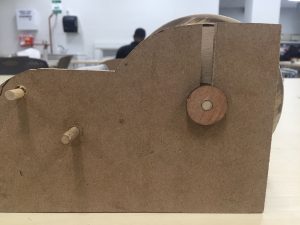
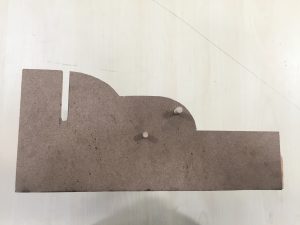
- Motor box
The motor box is made of 3/16 inch plywood and has six components: The bottom, four walls, and top. There is a hole on the top component for the potentiometer to rest in. These six components were attached with wood glue, and the complete box houses the Arduino and breadboard.
- Wheel
The wheel is made of a wooden circle that has one center hole that attaches the motor and one hole color to the outer edge that attached to the hand crank.
- Motor (automatic component)
We used a geared down DC motor, a motor driver, a 10K potentiometer, and an Arduino UNO. This motor turned the barrel at a certain, constant speed so the xylophone plays a tune at a constant rhythm.
The code for the Arduino UNO is as follows:
void setup() {
pinMode(5, OUTPUT);
Serial.begin(9600);
}void loop() {
int sensorValue = analogRead(A0);// Sensor value goes from 0 – 1023
int speed = 0;
Serial.println(sensorValue);
if (sensorValue > 1010)
{
speed = 90;
}
else
{
speed = 0;
}// below code would be used if you wanted the speed to go between a range,
// as opposed to switch on/off//int speed = 0.0489 * sensorValue + 80;
analogWrite(5, speed);
}
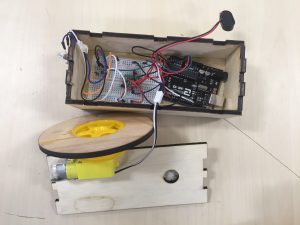

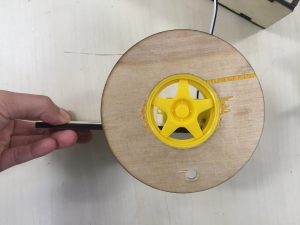
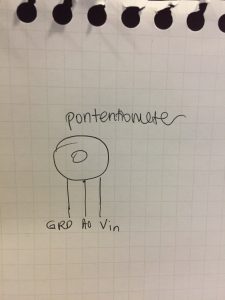

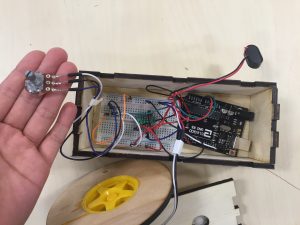
Cost
The following are the approximate costs for all materials to make this product.
- Barrel and wood for the base, spacers, hand crank, buttons, wheel, and motor box – $30 (The barrel and most of the wood was scrap wood found in the IDeATe lab and woodshop)
- Xylophone – $14.95
- Wooden dowels (0.25 inch) – $4.82
- Wooden dowels (3/16 inch) – $4.89
- Wood Round Beads – $5.68
- Wood glue – $3.19
- Arduino Uno – $20.00
- Bread board – $4.50
- Jumper wires – $4.00
- 10K Potentiometer – $0.80
- Motor Driver – $3.50
- Geared down motor – $8.95
Approximate total- $120
Extensions
A possibility for an extension would be to attach a speaker system that would play a set of notes, and ask the children to repeat the notes. This would allow them better learn how to distinguish between individual notes.
Handouts
- For parents and instructors:
Handout for parents and instructors
- For children:
